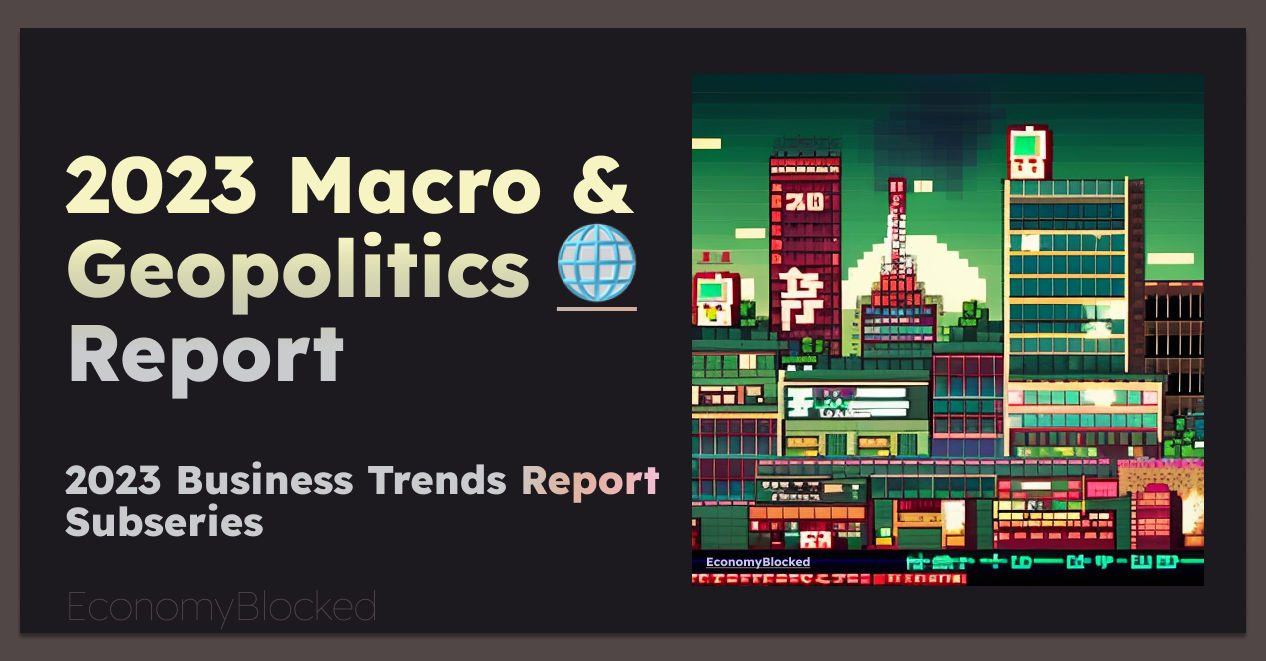💱 🌍 Intro
Welcome to Macroeconomics and Geopolitics Part 2, from the 2023 business trends subseries. If you have not read Part 1, which covered 2023 Geopolitics specifically, please read it first for context. Similarly to the geopolitics post, we will only be covering a few of the major macro, as well as geopolitical themes, rather than attempting to cover all of them, which would require an exhaustive amount of research.
For our first order of business, we’ll be reviewing a US economic outlook, as well as a chart to visualize the overall health of the US economy via changes to short-term interest rates(FedFunds) – Moving on, we will then cover the Euro-zone and the UK, the Ukrainian and Russian economies, Asia-Pacific region: China, Japan, and India, emerging markets, as well as a special attention section covering India geopolitics and foreign policy initatives for 2023.

🧩 Table Of Contents
🇺🇸 US Economic Outlook for 2023
🗽What to Expect from the US Economy in 2023
2023 will prove to be a year of significant change in the US economy – With the passing of the American Jobs Plan, the US government is investing an estimated $2 trillion into the US economy. This investment is expected to create more than 16 million jobs over the next 10 years and will have a substantial impact on economic growth.
During the pandemic, the US Federal Reserve kept interest rates low until 2022, when the Fed began tightening its belt. In response to inflation and an overheated job market, among other indicators, rates are likely to continue to rise for the foreseeable future to ensure more balance within an economy recovering from excessive capital flows.
A soft landing has been observed in consumer spending and the job market (as measured by unemployment claims). Many of these indicators and measures of economic performance will lag in the coming quarters, which will be a cause for concern.
The Us economy expanded by 2.1% in 2022, which is a reduction from the 5.9% growth experienced in 2021. Looking ahead to 2023, the macroeconomic situation is expected to be relatively unstable, with the likelihood of the US entering a recession increasing.
The US economy is projected to grow at a rate of around 0.5% - 1.4%, and inflation is projected to decrease in comparison to the previous 24 months, peaking in the fourth quarter of 2022, but remaining at a stable rate of 4.5-4.75% during 2023. Unemployment rates are also expected to remain steady, with estimates ranging from 3.5-4.0%.
🦅 The Impact of Current Economic Policies on the US Economy in 2023
Among the US government’s policy initiatives, the American Jobs Plan includes investments in infrastructure, research, and development, as well as targeted tax cuts for businesses and individuals to encourage and incentivize new businesses to both launch and hire.
As part of a broader fiscal consolidation effort, the government is expected to continue to reduce the federal budget deficit and debt. As a result of the pandemic, a number of industries are experiencing staffing problems, including healthcare, which we recently discussed in a post covering the healthcare industry, business trends and innovations as part of the business trends series; education and transportation are also experiencing a similar staffing issue to healthcare that is likely to persist in 2023 and into 2024 with no known solution to many of the problems as of now.
🏚️ Uncertainty Ahead: Hiring and the US Economy in 2023
The large-scale layoffs within technology companies have captured the media’s attention in recent months, but overall, there have been mass layoffs and staff reductions across a wide range of industries, many of which overhired during the pandemic to meet synthetic demand caused by the federal reserve and the government printing money by way of the PPE loans and other financial incentives, the stimulus checks included. This same trend has been somewhat consistent within much of the developed world, as well as within many emerging markets.
🗺️ The Implications of a Changing Global Economy for the US in 2023
New laws and regulations are likely to be enacted by the US government in the coming year, which will likely have a significant impact on the macroeconomic environment in 2023, and beyond: Cryptocurrencies, taxation, corporate governance, labor markets, and consumer protection will be some of the areas covered by these laws and regulations.
Deglobalization and the de-financialization of global markets are two other areas worth tracking closely as global trade shifts from a multi-polar to a uni-polar structure. A combination of the ongoing Ukrainian war and increased tension between the west, and China can be viewed as contributing factors to both deglobalization and de-financialization.

💶 Eurozone & 💷 UK Economic Outlook for 2023
🇪🇺 What to Expect from the Eurozone Economy in 2023
In the same vein as the US economy, there is no doubt that the European economy is headed for contraction or recession, but even more so than the US at this point; the extent of that recession is unknown, with some looming downside risks that could cause further contraction for the region in the coming quarters. High energy prices brought on by the ongoing conflict between Ukraine and Russia have caused a demand-side and trade shock, leading to an estimated 3%-4% reduction of GDP for the region. Many economists and models are proposing a mild recession, or correction, with the eurozone contracting by 0.5% by EOY 2023.
⚡ Uncertainty Ahead: What Could Derail the Eurozone Economy in 2023
2023 will be an important year for Europe, with high energy prices placing an increased strain on the eurozone economy. But the high-growth markets of the European region will continue to be a strong magnet for growth in the coming years, with their economy shifting toward protectionist movements for the first time since the fall of the Soviet Union. Putin and his regime pose an existential threat to the European Union, and most of its members, some of whom share a border with the Russian Federation, namely Norway, Sweden, Denmark, and Finland.
High energy prices have also caused inflation to increase to nearly 11%, which is currently 5x the target for inflation set by the ECB, which plans to continue hiking rates, on par with the actions taken by the US, with the goal of returning inflation to the 2% benchmark, a highly unlikely occurance.
It is projected that GDP is expected to grow by 1.6% in the EU, and by 1.5% in the euro area more broadly, down from closer to 2% in 2022. Inflation is currently sitting around 6.4% in 2023 - As per the European Commission’s latest forecast, the Eurozone economy will grow by 0.1% in 2022. This growth is driven by the continuing recovery of the Eurozone’s economy, supported by the European Central Bank’s (ECB) monetary policy and fiscal stimulus measures.
The German economy is still the highest-producing country in the EU, by a large margin in many ways, contributing a great deal of value to the world economy by way of high-quality exports, manufacturing, etc. Surprisingly enough, Seewdon is forecasted to be the worst-performing country in the EU in 2023, largely due to high-interest rates.
It will be somewhat interesting to see how each country in the EU rearms as a result of the ongoing war, which will lead to massive gains for each of the companies associated with defense and military production.

🇬🇧 What to Expect from the UK Economy in 2023
According to the Office for National Statistics, the UK economy contracted by -0.3% by EOY 2022. Consumer spending, investment, and exports are expected to be the main drivers of growth. Household expenditures dropped 1.1%, inventories fell, but exports increased to 8.9% boosted by nonmonetary gold. machinery, energy, heavy machinery, and transportation equipment. The UK economy is expected to continue contracting to roughly -0.6% in 2023, which represents the lowest level of growth in the entire G7.
🇺🇦 Ukraine Economy 2023
🪖 What to Expect from the Ukrainian Economy in 2023
In 2022, the Ukrainian economy contracted by roughly -30% which is the lowest rate of contraction in 40 years, measured as the gross domestic product decline (GDP Decline). Investments, exports, and private consumption are driving this weak growth, in combination with the ongoing territorial disputes; the proxy war between Ukraine and Russia.
In 2022, inflation will remain around 26.6% for the Ukrainian economy as the government maintains its current war-time monetary policy and manages public debt. It is expected that inflation will decrease to around 21.2% in 2023 - The US has contributed billions of dollars in aid in response to the ongoing war, which is planned to continue for the foreseeable future as the war drags on.

🇷🇺 Russia Economy 2023
⚠️ What to Expect from the Russian Economy in 2023
In 2022, Russian economic prospects were quite uncertain as a result of the ongoing Russia-Ukraine war. Russian economy in aggregate is significantly affected by oil prices, so fluctuations can be an important indicator of the country’s economic performance. Market uncertainties may increase even further as the conflict between Russia and Ukraine intensifies, or reaches a point of inflection.
☠ The Implications of a Changing Global Economy for the Russian economy in 2023
Some additional market forces are placing pressure on the Russian economy, including the overall macro climate and fiscal tightening across global markets, as the world is still in a period of convalescence after the COVID-19 pandemic, and attempting to find its baseline in a multi-polar world. Additionally, the planned destruction of the Nordstrom-2 pipeline is likely to cause further volatility in the region, cutting the Russian economy off from a critical source of revenue, which may be a % of GDP for the Russian economy.
❓ Uncertainty Ahead: What Could Derail the Russian Economy in 2023
Due to the country’s dependence on Oil exports to support thier overall economy, there is a direct interrelation between the Rubble to the US dollar and oil prices, which has been made evident using a regression model. When oil prices increase, the Russian economy grows. Conversely, when oil prices decrease, the Russian economy shrinks, which is exactly what occurred in 2014 when oil prices declined to the $50 US per barrel range.
With the world moving away from fossil fuels to zero- and low-emission sources of energy, the Russian economy will face its greatest existential threat since the end of World War II.
The Russian economy is expected to contract in the short term as sanctions remain in place and the ongoing war with Ukraine puts pressure on all parts of the economy. In 2022, their GDP is expected to shrink by roughly 3.7%, and by as much as 5.6% in 2023.

愛 🎌 Asia’s Economy 2023
Asia, namely Japan, China, and India, will experience the highest levels of overall growth measured as GDP in 2023 - but one independent variable must be addressed. In light of recent revelations about China and the CCP; many economists and business professionals are beginning to question the accuracy of China’s economic data.
🇨🇳 China’s Economy: That being said, China’s full-year GDP grew by 3% which is the lowest since 1976, when 2020 is excluded. Their GDP is expected to grow by 5.2%-6% in 2023. In 2022, the GDP was 3%, half what it was in 2021 of 6%. It is impossible to verify whether these figures are artificially inflated, but it is worth noting that they are cited from a private institution…
A significant amount of growth will occur in the third and fourth quarters of 2023. The demographic issue that the country is currently facing will also likely have a significant impact on the world economy in the coming years. Their population has decreased for the first time in 6 generations, with more people leaving the workforce every year than joining.
I would like to make a personal note about China’s economy to remove room for assumptions- Three of the most talented individuals I have ever worked with were from different parts of the country. Undoubtedly, they were among the most hard working, intellectually brilliant, and empathic team members, period. I believe that China is capable of providing irreplaceable value to the world economy, but I lack faith in the CCP, which I view as holding back one of the greatest assets to the world economy, it’s people.
In the years to come, loosening COVID-19 restrictions will lead to an increase in consumer spending, which will affect market condition, not only within China, but worldwide. Also, the CCP has been providing increased support to both the consumer and commercial real estate markets in response to the dramatic collapse of several of China’s largest real estate companies, including Evergrande Group in 2021, as well as the financial institutions holding the debt on their balance sheets.
Beyond the real estate market, public transport and utilities are also expected to rebound. The same worldwide themes will persist in 2023 for the Chinese economy: high inflation, high energy costs, and a staffing issue, uniquely due to a demographic collapse. Nevertheless, China will contribute a healthy amount to the world economy in 2023, accounting for still the highest rate of growth overall.
“We believe the reopening may lead to a V-shaped recovery in the share prices of China’s consumer brands in early 2023. The recovery could be driven by pent-up demand, high savings, and a wealth effect as real estate prices recover” ~ KraneShares’ international head, Xiaolin Chen.
⛩️ Japan’s Economy: Despite a rapidly aging population, Japan’s GDP grew by 1.74% in 2022. One of their greatest assets as a country is the excess cash and deposits households have saved throughout Japan, which will support a firm but steady growth into 2023, enabling the country to narrowly avoid a major recession, with a projected 1.07% growth rate, measued as GDP for 2023.

🇮🇳 India’s Economy: In 2022, India’s economy grew by 7%-8.7%. The greatest factors contributing to this growth have been the hotel and hospitality industry, transportation, construction, real estate, utilities, and financial services, among others.
Of those trends, offshoring of services to a well-educated English-speaking population, international investment in manufacturing, and an energy transition to more renewable sources of energy will remain some of the key themes supporting their economic growth for the coming fiscal year.
Based on the research I’ve conducted over the last year, I believe that India will not only surpass Japan and Germany as the third and fourth largest economies but also surpass China as the second, albeit marginally. It is important to note that this is an assumption that has not yet been well-tested or validated by data – To maintain transparency, I will present my analysis and subsequent hypothesis in another parallel post, referencing back to this research.
📈 Emerging Market Growth 2023
The economic numbers for emerging markets in 2022 will vary depending on the specific countries and regions. According to the International Monetary Fund (IMF), emerging market economies will grow by 5.1% in 2022 and are expected to grow by 5.5% in 2023.
As compared with 2020 and 2021, this represents an improvement from 4.7% and 4.3% growth, respectively. According to the IMF, emerging market inflation will remain relatively stable over the next two years, at 4.2% in 2022 and 4.3% in 2023.
🕌 🈲 Territorial Disputes, and Asia-Pacific (APAC) Geopolitics
For decades, Asian territorial land disputes have caused major geopolitical tensions throughout the region, due to the vastly differing political views of the countries in the region, and their alliances, and protectorates. The India-China border dispute in the Himalayas and the South China Sea dispute between multiple claimants have been at the forefront of regional geopolitics since the pre-covid era.
Several major events are expected to shape Asia’s political landscape in 2023, including the general election in India and its relationship with China. The Permanent Court of Arbitration will resolve the South China Sea dispute between China and the Philippines – Additionally, as their geopolitical rivalry escalates, the US may take additional measures to curb Chinese economic power. As an example, India recently provided $4 billion USD in aid and medical supplies to Shilanka after the country went into sovereign default, as part of its efforts to counter Chinese influence in the region.
Geopolitical tensions in Asia are likely to persist in 2023; There are likely to be more negotiations between India and China over their border dispute, and the South China Sea will continue to be a source of contention. There is no doubt that the United States will remain a major player in the region and will continue to take measures to counter Chinese influence. Therefore, business owners and teams should plan for continued geopolitical volatility in Asia and reassess their strategies accordingly.
Business strategic planning for 2023 is likely to focus on de-globalization, de-financialization, and the decoupling of manufacturing supply chains from China to new regions such as India. Consequently, businesses in Asia, as well as around the world, will face inflation, deflation, interest rate, and currency volatility in the years ahead, as we have reviewed throughout this research piece.
🇮🇳 2023 India Geopolitics and Foreign Policy
🕉 India Foreign Policy 2023
During the past few years, India has made significant progress in its foreign policy initiatives, focusing on developing strong bilateral and multilateral ties with neighboring countries – While maintaining strong ties with the US and Japan, India has also sought to reach out to Pakistan, Afghanistan, and China, to define frameworks for working through regional disputes and conflicts, which have been increasingly top-of-mind in recent months due to the threat of China invading Taiwan. The United States and India have agreed to enhance their trade and investment cooperation, infrastructure development, clean energy, and information technology cooperation by 2023.
Additionally, the two sides have signed a joint statement on enhancing security cooperation, and are in the process of drafting a defense framework agreement. Due to the India-US-Japan Quadrilateral Dialogue, India has also increased its engagement with countries such as Australia and the United Kingdom.
🥻 India territorial disputes and Asia-pacific region and subregions
There have also been territorial disputes between India and the Philippines, Pakistan, and Bangladesh in the Asia-Pacific region. In addition, India participates actively in regional organizations such as the South Asian Association for Regional Cooperation (SAARC), the Regional Comprehensive Economic Partnership (RCEP), and the Association of Southeast Asian Nations (ASEAN).
India has advocated multilateralism as part of its foreign policy, working to ensure regional and global stability in the region as a rising global power. Besides strengthening its ties with Africa, India plans to expand its presence in the Indian Ocean region, again, as a means of countering Chinese influence in the region, thus supporting US-led policies that aim to weaken China strategically.

🌐 🏅 Final Thoughts
In aggregate, the world economy is expected to decline from 2.4% in 2022 to 2.9% in 2023. As a result of the war in Ukraine and the ongoing trade war between China and the US, the main themes are high inflation, high energy prices, de-globalization, and de-financialization.
My research for the business trends series kicked off in November of 2022, spending hours upon hours aggregating information to present as part of the series – Not to be redundant, but the goal of this series has been to create resources that businesses and product teams can use as part of their strategic planning for 2023, and beyond.
The purpose of this post is to unpack and review some of the most important macroeconomic and geopolitical events of our time. Including the US economy in 2023, Europe, Ukraine, Russia, the Asia Pacific region, and India’s geopolitics and foreign policy initiatives.
I will be pivoting to focus on two more industry/sector-based business trend posts in the last few posts of the business trends series. Additionally, I will be providing a Bitcoin overview and price prediction within a few days of publishing this post. Also, I’ll be presenting a piece about Microlending as a resource for those who’re interested in Microfinance / Lending, as well as a piece about HotWire (HTML-Over-The-Wire).
👾 More Recent-Posts
-
Bitcoin (BTC) Revolution: Catalyst, History, and Analysis
The main goal of this piece is to gain a deeper understanding of the reasoning behind the creation of Bitcoin, allowing for a more comprehensive perspective on its future
-
💲NEAR Protocol: Overview and Price Prediction
In this article, we will be conducting an extensive analysis of the 💲NEAR protocol, which is the platform I have the most experience building dApps on, as a Product Manager in web3
-
8 Healthcare Industry Trends and Innovations
In this post, we will be reviewing 8 business trends for the healthcare industry, including each of it's sub-industries, such as MedTech🔬
-
Cardano(ADA) Overview and Price Prediction
As a part of this post, we'll be reviewing what Cardano (ADA) is, its benefits, Tokenomics, a price prediction model, and the future of its fledgling ecosystem 💱
-
Ruby on Rails and The Future Of MVC
Discover the amazing potential of Ruby on Rails! Learn about its history and design philosophy, why it's the perfect choice for web development, and how to get started with the framework ♦️
-
Artificial Intelligence: Business Trends Report
Large language and generative models are reaching a point of emotional realness that they can no longer be distinguished from humans 🚀
-
2023 Geopolitics Report
A guide to help both businesses and product managers use geopolitics as a strategic advantage in 2023
-
Post-Industrial Digital Banking
Explore the post-industrial era of digital banking. Deployment-based market research, post-industrial hypothesis validation,opportunities,and more 📲
-
How 👾 (AI) Will Transform Product Management
In this post, we will unpack how (AI) will transform aspects of product management, as well as it's impact across cross-functinoal teams 🎖️
-
2023 Transportation Industry Trends 🚊
In this post, we will be covering 2023 Transportation Industry Trends, including market research, business strategy, and more... 🚉
-
Energy Sector Forecast 2023 ⚡
The 2023 Business Trends Report covers sector-based projections, major innovations, market dynamics, opportunities, and technologies by sector or industry - this post covers both traditional and renewable energy markets 📈
-
To-Blog Or Not-To Blog❓ | 2023 Blog Launch Helper |
This post is designed to help you or your team launch and optimize a successful blog by examining why businesses blog, providing a blog business plan guide, exploring SEO and analytics tools, and an overview of blogging platforms and frameworks
-
Make the web fast again | What is a CDN❓| How do CDNs work❓
In this post, we review what a CDN is, how they work, the business of cdns, as well as some of the best options to consider when choosing a cdn
-
We're In Way Over Our Heads | Going Headless (CMS)
Content is king! In this post we review Headless-CMS, content management systems; How they work, an overview of JAMstack, some of the best options, etc, will be discuessed
-
Building Static Websites In An Un-Static-World (SSGs)
In this post we'll be reviewing (SSGs) static site generators, reviewing the tech as a means of providing value to your next project or business during times of uncertainty– The advantages, how they work, and evaluating frameworks, including Jekyll, Hugo, and Gatsby. JS, etc 🛠
-
How (AI) is changing the way we work
In this post, we'll explore two use cases for (AI) ⚔️ (AI) Writing and Text-To-Image (Generative-AI) – How they work, as well as their current and future, use cases for the workplace, as well as available tools and services
-
Industrial Revolutions
Part-1 (1-2 IR) This is the first post of the Industrial Revolution series, covering the 1st and 2nd Industrial Revolutions, major tech innovations and advancements during each period
-
Industrial Revolutions
Part-2 (3-4 IR) This is the second and final post of the Industrial Revolutions series, covering the 3rd and 4th Industrial Revolutions. Focusing on the tech and innovations during this period
-
Tokenomics
Ledgers and Accounting represent two foundational aspects of tokenomics and token-engineering, this is the first of many post where I will be covering tokenomics, focusing on presenting my research and aspects of system design
-
Fintech Deep-dive
How the tech industry is changing finance: This post outlines the history of financial technology (FinTech) and major innovations, as well as companies at the forefront of this sector
-
Web 3 Systemic Issues Report
In this post I review some of the most systemic-issues that I have identifed after contributing to a few web3 startups in varying levels of involvement – please take what is stated as speculative conjecture, nothing more 🙏